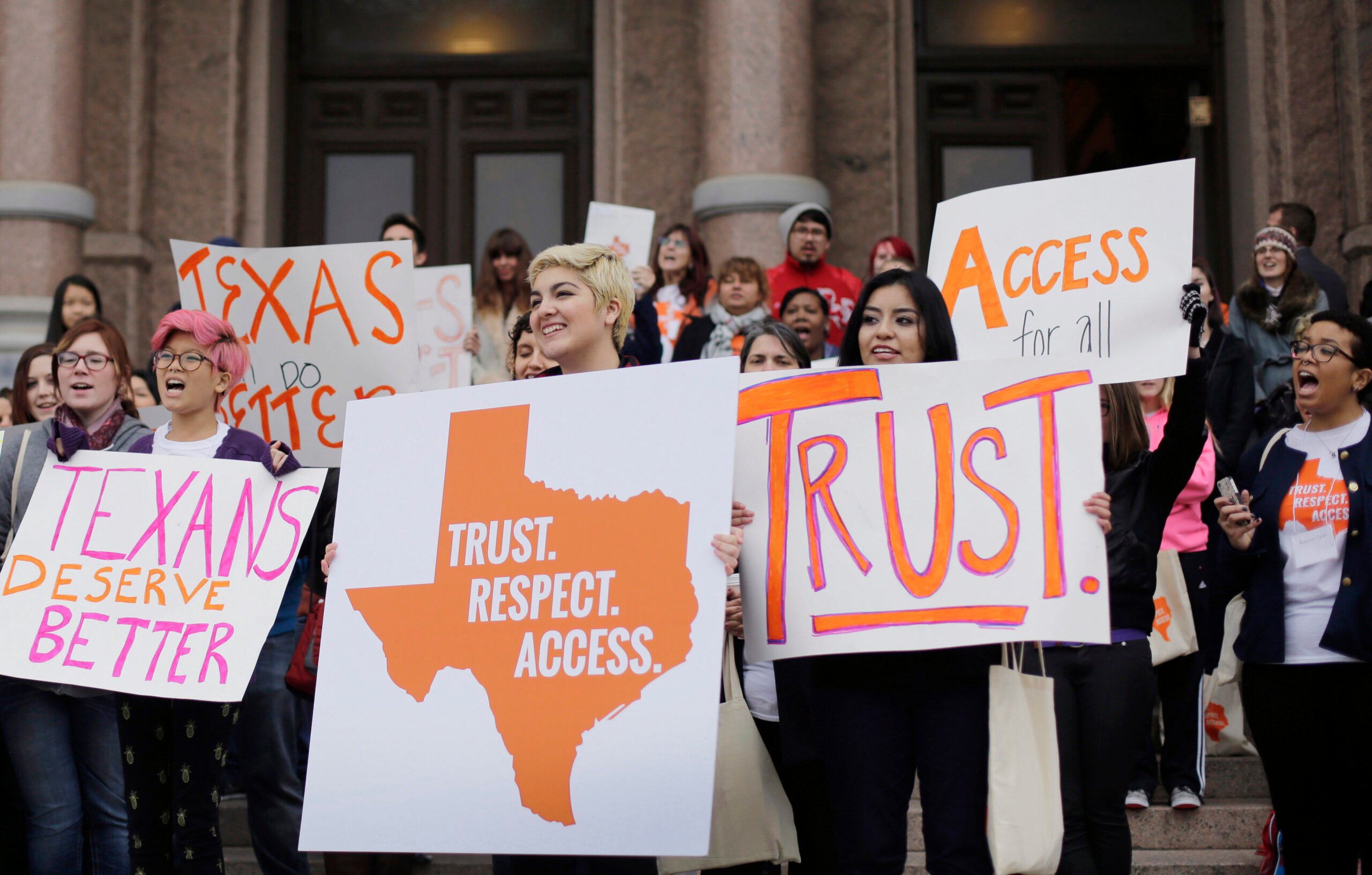
Need An Abortion In Texas? Don’t Be Poor.
For women struggling to pay for abortions, the Lilith Fund bridges personal choice and financial reality. But the Texas Legislature is poised to make abortion access even harder.
A version of this story ran in the May 2013 issue.
In a sun-filled home office in Austin, a voicemail crackles to life and the pleas for help begin. “I’m eight-and-a-half weeks along. My appointment is tomorrow. I’m in desperate need. It’s safe to leave a detailed message.” Beep.
“Hi, my name is [Sabine]. I’m 21 weeks. I’m going in tomorrow. You can leave me a message.” Beep.
“My name is [Gabriela]. My appointment is next Friday. You can leave a message. I’m about 10 or 11 weeks. I cannot continue with this pregnancy, because I already have four babies. I’m in school trying to get my certificate. It’s impossible for me to have another baby right now. … If you can help me I’d really appreciate it.” Beep.
Kat Craft cocks her head as she listens to each message. “[Sabine], 21 weeks,” she whispers to herself as she taps details into a spreadsheet. “[Gabriela]: Four kids. Didn’t say we could leave a message. [Alisha]: 15 weeks, needs $100. [Rachel]: Nine weeks. This is her third time calling.” She works rapidly to capture each woman’s predicament. As Craft types, the disembodied voices of desperate strangers—fragile and breathy, resigned and confident and tearful—fill the intimate space of her home office, a small room crammed with a desk, a music keyboard, neatly labeled box files and a friendly dog on the rug. Today there are 19 messages. Within half an hour, Craft’s spreadsheet is filled with names, dates and short summaries of why they need help.
 Craft works for the Lilith Fund, a volunteer-run organization that gives small grants to women seeking an abortion. It was founded in 2001 by a group of volunteers from the nonprofit, legal and medical fields. They raised $10,000 at the outset and began providing English- and Spanish-language counseling for women needing financial help to have an abortion. The group now has close to 30 volunteers fielding roughly 3,500 calls per year on its hotlines, which cater to women in South Texas. (Another abortion fund, the Texas Equal Access Fund, serves North Texas.) A pre-recorded message tells callers to leave their name, number, appointment date, how many weeks pregnant they are, and to state whether case managers can leave a message on their voicemail. “If they don’t say that it’s safe, then we don’t leave a message,” Craft says. It’s all governed by president Amelia Long and 14 volunteer board members. Kat Craft is the only paid staff member.
Craft works for the Lilith Fund, a volunteer-run organization that gives small grants to women seeking an abortion. It was founded in 2001 by a group of volunteers from the nonprofit, legal and medical fields. They raised $10,000 at the outset and began providing English- and Spanish-language counseling for women needing financial help to have an abortion. The group now has close to 30 volunteers fielding roughly 3,500 calls per year on its hotlines, which cater to women in South Texas. (Another abortion fund, the Texas Equal Access Fund, serves North Texas.) A pre-recorded message tells callers to leave their name, number, appointment date, how many weeks pregnant they are, and to state whether case managers can leave a message on their voicemail. “If they don’t say that it’s safe, then we don’t leave a message,” Craft says. It’s all governed by president Amelia Long and 14 volunteer board members. Kat Craft is the only paid staff member.
If a woman calls the Lilith Fund hotline, it’s because she wants an abortion but can’t afford one. For these women, the gap between their choice and what is economically realistic is wide. In Texas, the price of an abortion ranges from about $450 to $3,000, depending on how advanced the pregnancy is. For low-income women already struggling with rent, transportation, utilities and childcare (more than half of abortion-seeking women already have children), that sum is out of reach. Economic barriers to abortion are disproportionately high for African-American and Latina women. Long, the Lilith Fund president, noted that 85 percent of the group’s clients are women of color. Last year, the Lilith Fund granted money to 1,214 women—just a third of the women who called.
Having an abortion is expensive, even for women with health insurance. Though some private insurance plans cover the procedure, many abortion clinics require patients to pay up front. The Guttmacher Institute reports that two out of three women pay out of pocket for abortion, a significant challenge for the 69 percent of abortion-seeking women who are economically disadvantaged. The inequalities have grown since the 1977 Hyde amendment forbade Medicaid from paying for abortion in all but cases of rape, incest or life endangerment. As a result, the National Network of Abortion Funds estimates that nationwide more than 200,000 women a year need help paying for an abortion, and that a quarter of the pregnant women on Medicaid seeking an abortion are forced to continue with unwanted pregnancies because of financial barriers—births ultimately covered by taxpayers. To pay for an abortion, the Network notes, “low-income women sell their belongings, go hungry for weeks as they save up their grocery money, or risk evictions by using their rent money.” Low-income women are also more likely to be black or Latina, creating a triple-whammy of poverty, racial inequality and reduced abortion access, meaning that the most-vulnerable women have the least control over their reproductive health.
But nudging abortion further out of reach has become the favored strategy of anti-abortion legislators, especially in Texas. In 2004, the state forced clinics providing abortions after 16 weeks’ gestation to meet the same standards as ambulatory surgical centers. Theodore Joyce, a professor of economics at Baruch College of the City University of New York, studied the law’s effect on abortion providers and found that the following year, the number of women leaving Texas for later-term terminations increased fourfold. In 2005, the Texas Legislature enacted a law requiring minors to gain parental consent before having an abortion. Tina Hester, executive director of Jane’s Due Process, an organization that provides legal help for pregnant minors, noted that the requirements create significant barriers for teens. They must now navigate the court system if they wish to terminate a pregnancy without telling a parent. More recently, a 2012 law mandates that women undergo a 24-hour wait and a sonogram, which researchers at the University of Texas say increases costs for women. Meanwhile, in 2011, the Legislature slashed the publicly funded family-planning budget by two-thirds. Public health experts warned that the resulting loss in family-planning services would lead to more unintended pregnancies and more low-income women seeking abortions. To intensify poor women’s difficulties, in the current legislative session a host of anti-abortion bills under consideration would force many clinics to close and drive up prices for those that remain. In Texas, abortion is increasingly an option only for the rich.

An expensive wait
Craft runs her finger down each line of her spreadsheet, deciding which calls to prioritize. Today’s 19 callers need a total of more than $4,500, but Craft has only $600 to give. She murmurs to herself: “I’ll call the 17-weeks one, the woman with four kids, the 15-weeks one, the 21-weeks one, the woman who needs only $100 more.” She enters the amount she’ll give each caller in her spreadsheet, but a formula turns it red, warning that she’s exceeded her budget. “Who’s not going to get funded?” Craft mutters, leaning toward the screen. A mini version of the spreadsheet flashes in her glasses. “If we just gave her $50? … Okay. Let’s begin.”
Craft does a few stretches before clearing her throat and dialing the number of her highest priority caller. (The Observer has changed the names of women in this story, at the Lilith Fund’s request, to protect the privacy of callers.) “Is that [Sabine]?” Craft says.
“Yes.”
“Hi, it’s Kat from the Lilith Fund. Is now an okay time to talk?”
“Yeah it is.” Sabine sounds self-possessed, as if she were taking a call from a friend.
“Okay, great. So I have here that you are 21 weeks and your appointment is tomorrow and your total procedure cost is going to be $2,670. Is that right?”
“Yes ma’am.”
“Okay. And how much money do you have to contribute toward the total cost?”
“I only have $670.”
Sabine is well into her second trimester. She didn’t say why she’d waited till 21 weeks to have the abortion, and Lilith Fund case workers don’t ask. It’s possible that her fetus has a serious anomaly just discovered at the routine 20-week ultrasound. Or she may fall into one of the determinants identified by a Guttmacher Institute study for having a second-trimester abortion: among other things, being an adolescent, or having experienced recent disruptive life events such as separation, unemployment or childbirth. Rachel Jones, the study’s author, suggests that these groups may have recognized the symptoms of pregnancy later, had a harder time finding information about abortion, or struggled to find the cash for a first-trimester termination. Guttmacher Institute research shows that 70 percent of women who had later-term abortions said that they would prefer to have had an earlier abortion but needed time to raise the money. Abortion-seeking women pay a hefty financial penalty for being poor.
For each week that Sabine delayed getting an abortion, the cost ballooned. Price quotes from two of Planned Parenthood’s abortion-providing affiliates range between $450 and $550 before 12 weeks, about $1,000 at 17 weeks, and roughly $1,600 or more from 18 weeks onward. Planned Parenthood, like most abortion providers, offers financial discounts to low-income clients. Even so, many women, like Sabine, still can’t bridge the gap between what they want and what they can afford.
Craft pauses before delivering the heavy news to Sabine. “We can actually only fund very small amounts. I can offer you $100 to help with this procedure. Do you have the resources to raise the rest of the money?”
“Um, no,” says Sabine. Her voice grows distant.
“Okay, I’m going to ask you some questions about your personal situation,” Craft replies. Working off a script used by all hotline volunteers, Craft prepares to ask Sabine whether she has supportive family or friends, the option of a salary advance, or anything she can pawn. Craft will also refer her to the National Network of Abortion Funds, a fund set up to help women in their second trimesters, but she doesn’t get the chance to do so because Sabine suddenly says that she has to go and hangs up.
“I’ll hold that $100 for her,” Craft says, “just in case she calls back.”

“I had to tell her because I needed the ride”
Martha, an unemployed mother of two, is 16 weeks pregnant and needs to raise $380 by tomorrow. The abortion clinic has already offered her financial assistance, but she still can’t afford the procedure. The urgency is clear in Martha’s voice. “I want to do this before it gets too far along,” she tells Craft. “If I start feeling it, then I won’t be able to go through with it.” Craft offers her $100 and asks if she has anyone to help her raise the rest. Martha gives a deep sigh. “My mom’s the only one who knows,” she says. “My boyfriend doesn’t work, and he doesn’t even know. I couldn’t ask my mom … she’s already pissed that I’m not working, but I had to tell her because I needed the ride.”
The ride Martha referred to is the 50-mile round trip to the abortion clinic so that she could have a government-mandated sonogram. In January 2012, a law came into effect requiring Texas women seeking abortions to hear a clinician describe the fetus’ physical characteristics and to view it on a screen. They must then wait 24 hours before proceeding with the abortion. The waiting period and mandatory ultrasound has added personal, financial and logistical barriers to getting an abortion. In a 2012 survey conducted by the Texas Policy Evaluation Project at UT-Austin, women had to travel an average of 42 miles to have their consultation. Some traveled more than 400 miles. The research team discovered that almost one-quarter of women found it hard to get to the clinic for the sonogram. On average, the women in the survey spent an extra $146 on travel, accommodation, childcare and lost wages to comply with the sonogram law requirements.
Craft makes a note to send the $100 voucher directly to Martha’s clinic. She breathes deeply before moving on to her next call.
Geography is destiny
“Hi Eva, it’s Kat calling from the Lilith Fund. Is now a good time to talk?” Eva confirms that it is, but she is clearly at work because she gives muffled instructions to someone in the background. Eva is a single working mother of two children living in a small rural community. She is 12 weeks pregnant and must travel more than 100 miles to her nearest abortion clinic. Eva needs to raise $300 to pay for the abortion. The loan she’d just applied for was declined.
“Is there anyone else you can ask?” says Craft, patiently waiting to ask her questions during gaps in Eva’s parallel conversation.
“Honestly, everyone’s against what I’m going to do,” Eva says. Her voice is flat, as if she’s discussing someone she barely knows. Craft offers Eva $75 and recommends she ask the clinic for a discount.
For rural women like Eva, geography is often destiny. According to the Guttmacher Institute, 92 percent of Texas counties don’t have any abortion provider. For women past 16 weeks gestation, the problem of access is acute. Following the 2004 ambulatory care center law, there are now only six providers that offer later-term abortions. Women not living in Austin, Houston, Dallas or San Antonio must travel significant distances to receive abortions past 16 weeks; the women more likely to need them are those who couldn’t raise the money in time to do it earlier.
Things could soon get much worse. The Legislature is considering Senate Bill 537, which would force all abortion clinics—even those providing early-term abortions—to comply with the same standards as ambulatory surgical centers. Critics of the bill argue that the law doesn’t improve safety but is rather an effort to close clinics by setting standards that would require costly upgrades. Abortion-rights advocates say only five clinics in the state could meet the surgical center standards. The other 32 clinics would have to either upgrade or shut their doors. In testimony to state senators, Amanda Stevenson, a graduate student researcher with the Texas Policy Evaluation Project, noted that if this were to happen, women not living in one of Texas’ major counties would have to travel 125 miles on average to reach a complying abortion provider.
Birth control out of reach
Not long after her local family-planning clinic stopped providing free birth control, June became pregnant. “I had to start paying out of pocket, and I couldn’t afford it,” she tells Craft. June is a 21-year-old community college student and is 15 weeks along. The total cost of her abortion is $660, and she has raised all but the last $100. June tells Craft that she recently lost her job. “I’ve been really stressed out trying to find the money,” she says. Craft offers her a $50 voucher, for which the young woman is profusely grateful.
Craft tells me later that June is her first caller to say she’d become pregnant because she couldn’t afford birth control. But she may not be the last. In 2011, the Legislature voted to defund family-planning clinics, causing many to reduce their hours, charge for services previously free, or close shop. More than 60 family-planning providers have closed—the large majority of them not affiliated with Planned Parenthood, the target of lawmakers’ ire. Affordable contraception is now much harder to find. The Texas Policy Evaluation Project found that 23 percent of the women in its survey had problems accessing birth control due to cost, lack of insurance coverage, or inability to find a clinic. Indeed, The Texas Tribune reports that the Texas Medicaid program is bracing for the cost of an additional 24,000 births as a result of reduced access to family-planning services. Each birth will cost the state roughly $11,000.
Craft finishes the last calls of her shift. Her spreadsheet shows a few green strips for the women she can fund, amid a screen of unfunded red. Craft has spent hours brainstorming fundraising opportunities with women, urging them to advocate for themselves, or simply listening to them talk. She has spent her whole budget but has barely aided the women who can afford neither to terminate or carry to term. Craft pauses to rest, peeling a clementine while staring pensively out the window. The room, brimming with stuff yet immaculately ordered, seems an extension of Craft herself—busy, creative (she also runs theater workshops at the county jail) and practical. She politely bats away my questions about abortion politics, emphasizing that what matters most to her is that she provides direct services—solid, tangible help—to women at a crossroads in their lives.
I later asked Craft what happened to the callers. Lilith Fund records don’t show whether June, the college student who lost access to birth control, went ahead with the abortion, and her phone was switched off. Martha, the woman who needed a ride from her mother, did use the Lilith Fund’s $100 voucher for an abortion. Though she initially agreed to a follow-up interview, she never responded to calls. Eva, the one who lived in the small town, did get an abortion but later couldn’t be reached because her phone had been disconnected.
Sabine, the woman who needed $2,000 by the next day, never called the hotline again.


